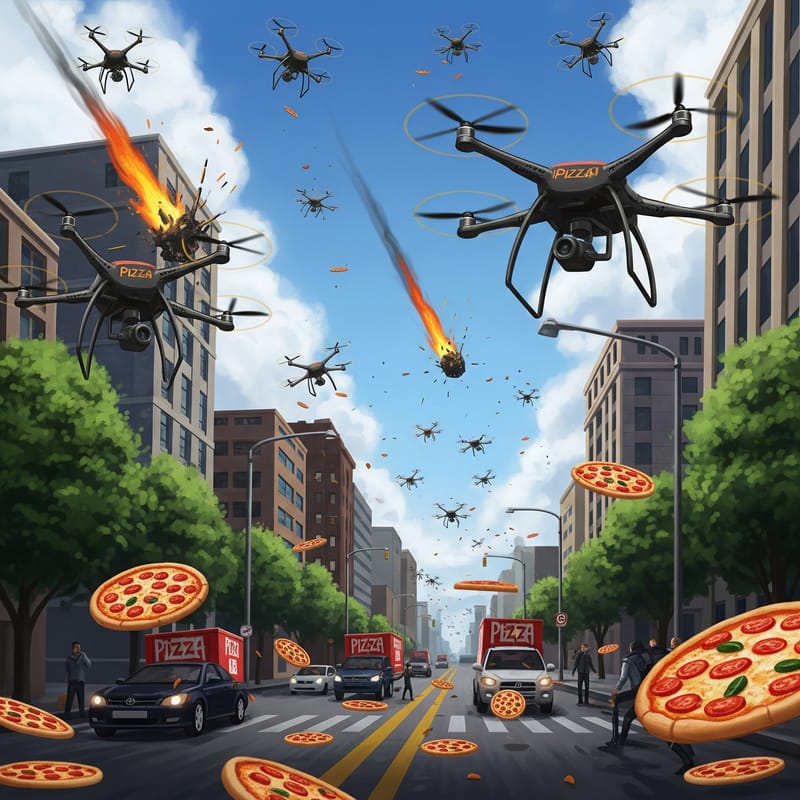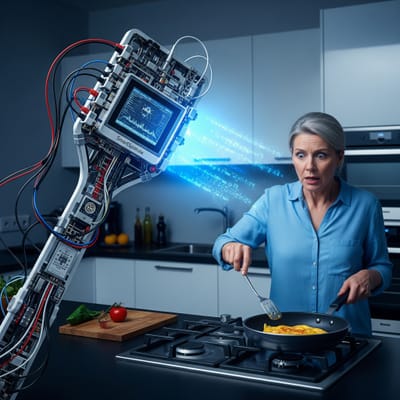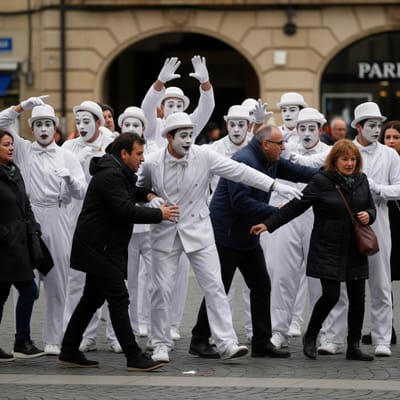The Drone Delivery Debacle: A Question of Unmanned Pizza
Why: This directly challenges his focus on "practical consequences." Drones crashing, misplaced items, and aerial anarchy are the antithesis of efficiency and order. He would likely view this as an ill-conceived technological implementation that creates more problems than it solves, failing utterly in its "purpose" (efficient delivery). The immediate, tangible negative outcomes would be very "Breyer's Eye Scream" worthy.
The rapid advancements in drone technology have tantalized entrepreneurs with visions of a seamless, sky-borne delivery network. Enter the city of Aero Heights, a municipality that, in its zeal for innovation, decided to become the North American testing ground for "SkySlice," a revolutionary drone-based pizza delivery service. Under a newly enacted city ordinance, "The Aerial Efficiency Act," SkySlice was granted exclusive rights to deliver hot food via drone within city limits, effectively sidelining traditional ground-based delivery services. What began as a futuristic experiment quickly descended into a chaotic, whirring nightmare, leading to Aero Heights Residents for Quieter Skies v. SkySlice Inc., a case now hovering precariously before the Supreme Court.
Justice Stephen Breyer, with his characteristic emphasis on pragmatism and the practical consequences of laws and policies, would undoubtedly find the "Drone Delivery Debacle" to be a case ripe for his particular brand of judicial scrutiny. For Breyer, the ideal legal outcome is one that works effectively in the real world, achieving its intended purpose without creating undue burdens or unforeseen negative externalities. The aerial anarchy of unmanned pizza delivery would present a perfect storm of such issues, challenging the very notion of "efficiency" and "order."
When Innovation Crashes into Practicality
Breyer's Eye Scream!
Breyer would, first and foremost, dissect the stated purpose of The Aerial Efficiency Act: faster, more efficient delivery. He would then compare this lofty goal with the actual, observable consequences on the ground (and in the air). The vision of swift, silent drones zipping through the sky, gently lowering a piping hot pepperoni, would quickly dissipate under the weight of reality.
Consider the immediate, tangible negative outcomes. Drones, despite their sophistication, are not infallible. The skies over Aero Heights would quickly become a hazard zone:
- Crashes: Every so often, a drone would inevitably malfunction, plummeting from the sky. What happens when a drone carrying a pizza (or worse, something heavier) crashes into a car, a rooftop, or a pedestrian? The potential for property damage and personal injury would be significant. Breyer would question the city's liability, the insurance implications, and the sheer danger posed by a sky full of falling objects.
- Misplaced Items: GPS glitches, wind gusts, or simply human error in programming could lead to pizzas landing in the wrong backyard, on a neighbor's porch, or even in a tree. This isn't just an inconvenience; it's a failure of the core purpose of delivery – getting the right item to the right person. The resulting disputes, complaints, and resource drain on customer service would be immense.
- Aerial Anarchy & Noise Pollution: Imagine the incessant hum and whirring of dozens, if not hundreds, of drones constantly overhead, particularly in residential areas. This isn't the quiet hum of a refrigerator; it's a persistent, high-pitched buzz that invades homes, disrupts sleep, and destroys any semblance of outdoor tranquility. For Breyer, the quality of life for citizens is a critical practical consideration. A law that exchanges a minor convenience (faster pizza) for a major degradation in the living environment would fail his pragmatic test.
- Privacy Concerns: Drones equipped with cameras, even if ostensibly for navigation, raise significant privacy issues. Residents would understandably be concerned about aerial surveillance, whether intentional or accidental, of their backyards, windows, and daily activities. This would be a subtle but pervasive erosion of the right to privacy, a consequence Breyer would likely view with concern.
- Security Vulnerabilities: A sky full of drones presents potential security risks. Could they be hacked? Could they be used for malicious purposes, or could their flight paths be exploited? These are not hypothetical concerns in a world increasingly reliant on digital infrastructure.
Breyer's inquiry would extend beyond these immediate issues to the broader implications for public resources and regulatory frameworks. How would air traffic control be managed for these low-altitude commercial flights? Who would be responsible for regulating the safety standards, maintenance, and flight paths of these thousands of private aircraft? The existing legal framework for airspace, primarily designed for manned aviation, would be woefully inadequate for a decentralized network of delivery drones. This would create a regulatory vacuum, leading to further chaos and potential danger.
Furthermore, Breyer might question the economic impact. While SkySlice might promise efficiency, what about the traditional pizza delivery drivers who are suddenly out of work? While technological advancement is generally positive, Breyer often considers the social costs and benefits of new policies. A rapid, unregulated shift could create significant economic dislocation for a segment of the workforce, a practical consequence that courts sometimes weigh.
The ordinance granting SkySlice exclusive rights would also raise concerns about antitrust and fair competition. By creating a monopoly, the city could be stifling innovation from other delivery models and limiting consumer choice. Breyer, as a proponent of markets that function effectively, would view such an exclusive arrangement with skepticism, analyzing its practical effect on competition and consumer welfare.
In the courtroom, Breyer would likely engage in his characteristic Socratic method, pressing the city's attorneys and SkySlice representatives on the myriad practical problems. He might pose questions like: "If a drone drops a pizza on a child's head, who is liable? What recourse does a homeowner have if a drone is constantly hovering over their backyard? How do you ensure these drones aren't used for nefarious purposes?" He would cut through the futuristic rhetoric to expose the messy realities.
Ultimately, "The Drone Delivery Debacle" would serve as a powerful illustration of Breyer's pragmatic skepticism towards technologies or policies that sound good on paper but fail miserably in execution. He would likely find that the "purpose" of efficient delivery is entirely undermined by the negative consequences of crashes, noise, privacy invasion, and a general state of aerial disorder. The ordinance, instead of fostering innovation, would be seen as creating a public nuisance and a regulatory nightmare. For Breyer, the skies over Aero Heights, far from being a testament to progress, would be a stark reminder that even the most innovative ideas must, at their core, be practical, safe, and ultimately serve the public good without eroding fundamental liberties or creating a state of perpetual chaos. The unanimous rejection of unmanned pizza might just be the "Breyer's Eye Scream" heard 'round the legal world.
Video created with Gemini Pro for the Eye Scream series, a tribute to Justice Stephen Breyer.






